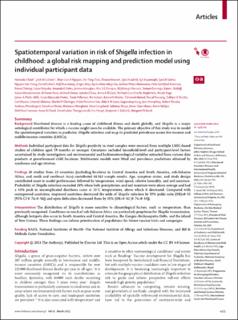Spatiotemporal variation in risk of Shigella infection in childhood: a global risk mapping and prediction model using individual participant data
Badr, Hamada S; Colston, Josh M; Nguyen, Nhat-Lan H; Chen, Yen Ting; Burnett, Eleanor; Ali, Syed Asad; Rayamajhi, Ajit; Satter, Syed M; Van Trang, Nguyen; Eibach, Daniel; Krumkamp, Ralf; May, Jürgen; Adegnika, Ayola Akim; Manouana, Gédéon Prince; Kremsner, Peter Gottfried; Chilengi, Roma; Hatyoka, Luiza; Debes, Amanda K; Ateudjieu, Jerome; Faruque, Abu S G; Hossain, M Jahangir; Kanungo, Suman; Kotloff, Karen L; Mandomando, Inácio; Nisar, M Imran; Omore, Richard; Sow, Samba O; Zaidi, Anita K M; Lambrecht, Nathalie; Adu, Bright; Page, Nicola; Platts-Mills, James A; Mavacala Freitas, Cesar; Pelkonen, Tuula; Ashorn, Per; Maleta, Kenneth; Ahmed, Tahmeed; Bessong, Pascal; Bhutta, Zulfiqar A; Mason, Carl; Mduma, Estomih; Olortegui, Maribel P; Peñataro Yori, Pablo; Lima, Aldo A M; Kang, Gagandeep; Humphrey, Jean; Ntozini, Robert; Prendergast, Andrew J; Okada, Kazuhisa; Wongboot, Warawan; Langeland, Nina; Moyo, Sabrina John; Gaensbauer, James; Melgar, Mario; Freeman, Matthew; Chard, Anna N; Thongpaseuth, Vonethalom; Houpt, Eric; Zaitchik, Benjamin F; Kosek, Margaret N
Journal article, Peer reviewed
Published version

Åpne
Permanent lenke
https://hdl.handle.net/11250/3091341Utgivelsesdato
2023Metadata
Vis full innførselSamlinger
- Department of Clinical Science [2295]
- Registrations from Cristin [9489]
Sammendrag
Background
Diarrhoeal disease is a leading cause of childhood illness and death globally, and Shigella is a major aetiological contributor for which a vaccine might soon be available. The primary objective of this study was to model the spatiotemporal variation in paediatric Shigella infection and map its predicted prevalence across low-income and middle-income countries (LMICs).
Methods
Individual participant data for Shigella positivity in stool samples were sourced from multiple LMIC-based studies of children aged 59 months or younger. Covariates included household-level and participant-level factors ascertained by study investigators and environmental and hydrometeorological variables extracted from various data products at georeferenced child locations. Multivariate models were fitted and prevalence predictions obtained by syndrome and age stratum.
Findings
20 studies from 23 countries (including locations in Central America and South America, sub-Saharan Africa, and south and southeast Asia) contributed 66 563 sample results. Age, symptom status, and study design contributed most to model performance followed by temperature, wind speed, relative humidity, and soil moisture. Probability of Shigella infection exceeded 20% when both precipitation and soil moisture were above average and had a 43% peak in uncomplicated diarrhoea cases at 33°C temperatures, above which it decreased. Compared with unimproved sanitation, improved sanitation decreased the odds of Shigella infection by 19% (odds ratio [OR]=0·81 [95% CI 0·76–0·86]) and open defecation decreased them by 18% (OR=0·82 [0·76–0·88]).
Interpretation
The distribution of Shigella is more sensitive to climatological factors, such as temperature, than previously recognised. Conditions in much of sub-Saharan Africa are particularly propitious for Shigella transmission, although hotspots also occur in South America and Central America, the Ganges–Brahmaputra Delta, and the island of New Guinea. These findings can inform prioritisation of populations for future vaccine trials and campaigns.
